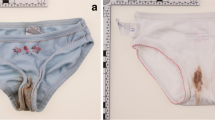Abstract
Lower urinary tract symptoms is a well known presentation of the presence of foreign bodies inside the bladder. Most such cases are diagnosed by chance, while investigating unrelated conditions. We present the transvesical endoscopic extraction of a surgical sponge that migrated to the bladder six years after an inguinal hernioplasty.
Similar content being viewed by others
References
Yalycin V, Demirkesen O, Alici B, et al. An unusual presentation of a foreign body in the urinary bladder: A migrant intrauterine device. Urol Int 1998; 61(4): 240–242.
Duron J, Ellian N, Olivier O. Postoperative peritoneal adhesions and foreign bodies. Euro J Sur 1997; suppl 579: 15–16.
Willian Kaiser C, Friedman S, Pfeifer K, et al. The retained surgical sponge. Annals of Surgery 1996; 224(1): 79–84.
Beshai AZ, Flashner SC, Walther PJ. Endoscopic release of retained penrose drain: a simple solution for an old problem. J Urol 1992; 147: 1067.
Author information
Authors and Affiliations
Rights and permissions
About this article
Cite this article
Tornero, J., Palou, J., Prados, M. et al. Bladder perforation caused by foreign body migration. Int Urol Nephrol 32, 241–243 (2000). https://doi.org/10.1023/A:1007131017611
Issue Date:
DOI: https://doi.org/10.1023/A:1007131017611




